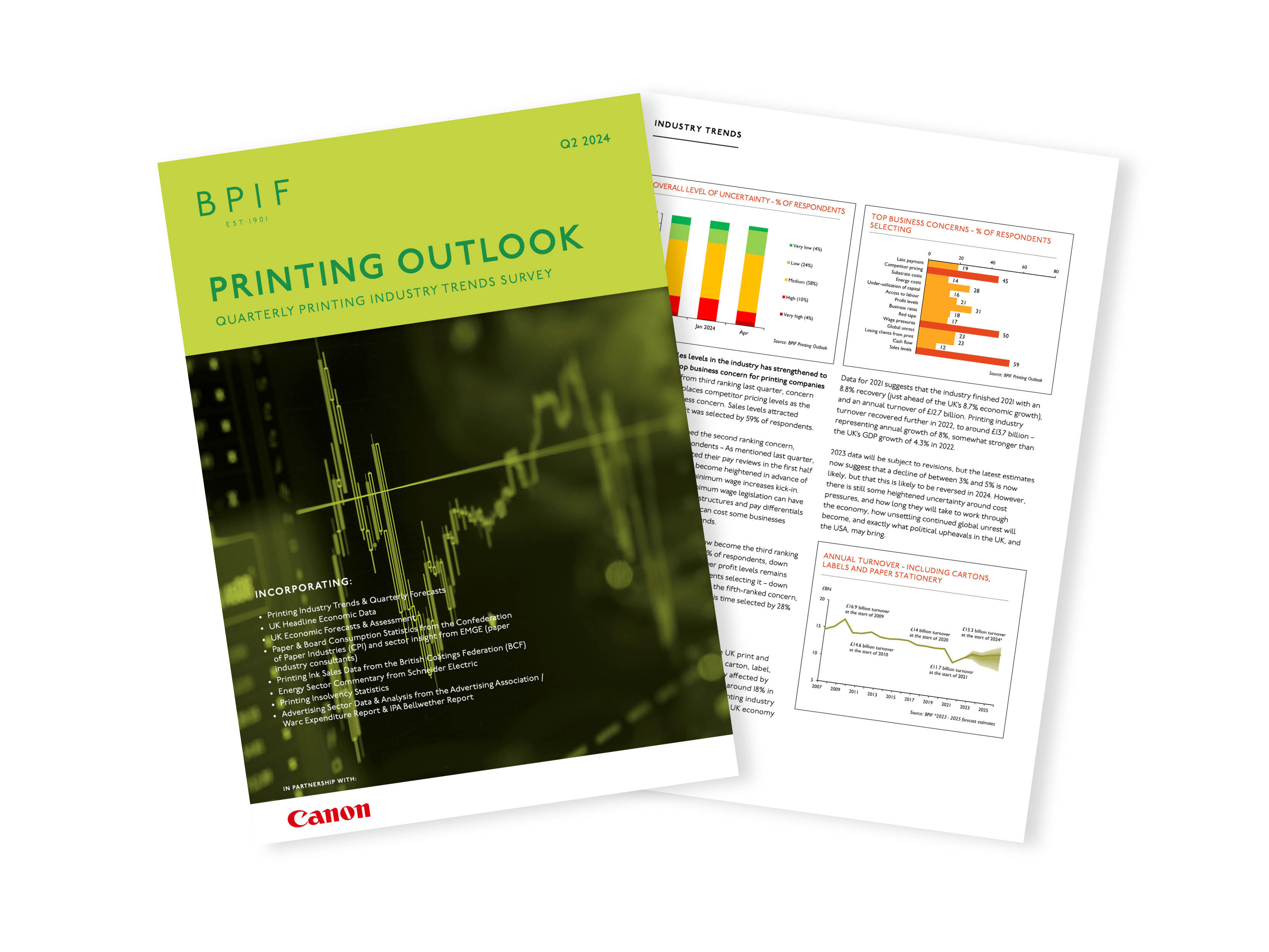14 May 2024

Output and order growth maintained in Q1 - confidence boost for Q2 as growth expectations rise
The BPIF has published its latest Printing Outlook report, the Q2 2024 edition shows that output and orders growth didn't quite match the expectations for Q1, but we have now had two consecutive quarters of growth, which is more than we have had since 2022. Printing industry activity is expected to experience a stronger pick-up in Q2.
VOLUME OF OUTPUT - LOW GROWTH HELD IN Q1, STRONGER GROWTH COMING

The output balance of +5 was below the forecast of +8 for Q1. A balance of +25 is forecast for Q2.
Whilst the aggregated data has shown some stabilisation and improvement, much of that improvement is based on expectations for Q2. The Printing Outlook survey is still picking up mixed signals on the state of trade, and plenty of opinions on a number of issues companies are currently experiencing. On the general economy, and the environment companies are operating in - inflation is coming down, just not as quickly as might have been expected; interest rates are staying high, a costly annoyance to those repaying Government Covid loans; business rates are critically high for some companies; increasing administrative and compliance burdens on companies; but perhaps the most voiced annoyance was with the increase to the National Living Wage.
The new Q2 2024 Printing Outlook report contains an expanded section on sustainability, showing the growing importance of tackling sustainability issues, accountability, and enhancing sustainability credentials in the printing and printed packaging industry.
In April, 70% of respondents reported that they are measuring their carbon emissions (50% for more than 12 months, and a further 20% for less than 12 months), up from 56% in October, and 38% in April last year. That now leaves 29% not yet measuring their emissions, and a further 1% of respondents that weren’t sure if their company was measuring emissions or not.
MEASURING CARBON EMISSIONS - % OF RESPONDENTS

The BPIF Printing Outlook Q2 2024 report features sections on industry turnover, business concerns, sustainability, costs, pay reviews, paper and board, and much more.
Kyle Jardine, BPIF Economist, said:
"To elaborate on respondents' comments related to the National Living Wage - companies do not wish to obstruct a fair wage being paid; in fact, many can benefit from having an open and transparent annual wage increase. However, the knock-on effect on maintaining wage differentials throughout the various skills employed can easily double budgeted pay rises. There can also be difficulties created in recruiting, and skill progression within companies, as a result of significant increases in minimum wages catching up with more skilled occupations.
"Despite these issues being raised - companies in the printing and printed packaging industry are working hard to maintain cash flow and profit levels. Controlling costs, productivity gains through capital investment, and diversification have all been key strategies companies are pursuing to ensure their survival."
Charles Jarrold, BPIF Chief Executive, said:
"Printing Outlook plays a crucial role in monitoring what is happening in our industry, we can more clearly see how the importance of sustainability is being accepted and acted upon. When we look at emissions measurement, it is promising to see that, in the last year, there has been a noticeable progression from companies starting measuring, through measuring just Scope 1 and 2, to incorporating Scope 3.
"Of course, measuring emissions is only a start, over four-fifths of respondents (82%) are working to reduce their carbon footprint. In the coming months we expect to see more companies setting emission reduction targets, and getting their targets validated by organisations like the Science Based Targets Initiative (SBTi).
"Finally, and as we eagerly approach drupa - Printing Outlook suggests that the industry is generally more positive, which sets the scene for a really excellent expo for attendees and exhibitors, particularly as the new Q2 report shows that printing companies are interested in capital investment - especially if it can help boost productivity."
Khalid Aziz, Marketing Director, DP&S, Canon UK & Ireland, and sponsors of the Printing Outlook report, said:
"With the knowledge that print businesses are seeking substantial gains in productivity, versatility and operational efficiency, our new innovations not only demonstrate the ongoing enhancements we offer to our existing portfolio, but also how our sustained investment in R&D and unwavering commitment to the printing industry can disrupt and support the market. As such, we'll be leading with a range of significant innovations and our drupa visitors will be the first in Europe to see many of these. We're giving our customers more printing firepower, expanding their application range and integrating intelligent automation features to simplify routine tasks enabling them to focus on adding value.
"Once again, we'd like to thank the BPIF and its members for their continuous hard work and look forward to working together, throughout 2024."
Summary of key findings:
- Concern over sales levels in the industry has strengthened to make it the new top business concern for printing companies once more.
- Industry capacity utilisation remains concentrated in the 70-89% range in April, as it was in January.
- More companies increased, than decreased, employment levels in Q1. However, recruitment success has often struggled to hit the expectations for securing new employees. Despite this, recruitment expectations remain positive for Q2.
- Average price levels continued to decrease, on balance, in Q1, although a slender majority did manage to hold their prices steady.
- Labour costs remain the most prominent costs concern for companies, but there are signs that pressure is building for other cost increases. More companies are now starting to see a return of paper price increases.
- A majority of printing companies were able to hold margins steady in Q1, but margins remain under increased pressure, on balance, as the cost increase and price reduction squeeze is maintained.
- When it comes to company plans to increase profitability in the next twelve months, cost control remains the primary area of focus, as it has since July 2023.
- Just over half (52%) of respondents reported that they had conducted a pay review in Q1, the resulting average (mean) change in basic pay was 5.1%.
- Export orders exceeded 5% of turnover for 18% of respondents in April, up from 12% in January. For these companies export orders continued to perform poorly in Q1.
- The importance of tackling sustainability issues, accountability and enhancing sustainability credentials continues to grow in in the printing and printed packaging industry.
- In April, 70% of respondents reported that they are measuring their carbon emissions.
- There has been a noticeable progression from companies starting measuring, through measuring just Scope 1 and 2, to incorporating Scope 3 in the last year.
- Over four-fifths of respondents (82%) are working to reduce their carbon footprint.
- The post popular area of attention for sustainability related investments remains waste reduction, selected by 68% of respondents.
- UK consumption of printing papers and boards in Q4 recovered slightly from the record low recorded in Q3. Early data for 2024 is looking considerably stronger in comparison to 2023.
- The last three months has seen a moderate quarter-on-quarter rebound in natural gas and electricity wholesale prices, after an initial dip in February to levels last witnessed nearly three years ago.
Featured in Printing Outlook this quarter:
- Output and orders - last quarter and forecast for this quarter.
- Business confidence, concerns, and uncertainty levels.
- Turnover - annual and monthly turnover analysis and forecasts.
- Capacity - utilisation and constraints.
- Costs - paper & board, ink, labour, energy, and average cost structure.
- Trend data on employment, prices, costs, margins, profits, cash flow and productivity.
- Profitability benchmarks and plans for improvement.
- Pay Reviews - activity and average % changes.
- International trade - export orders and price trends.
- Sustainability - measuring, reducing, and investing.
- Consumables - paper consumption and printing ink data.
- Energy - sector update and comment.
Downloads
 INTERGRAF OPENS APPLICATIONS FOR THE 2025 YOUNG TALENT AWARD
INTERGRAF OPENS APPLICATIONS FOR THE 2025 YOUNG TALENT AWARD
4 December 2024
Intergraf is pleased to announce that applications are now open for the 2025 Young Talent Award, an initiative designed to inspire and shape the future of the print industry. This year, the Award invites young talent to explore how print companies can effectively attract and engage younger generations to pursue careers in the print industry.
 Intergraf Economic News (Paper Prices) - December 2024
Intergraf Economic News (Paper Prices) - December 2024
5 December 2024
Access the latest edition of the Economic Newsletter for the European Printing Industry for data on paper consumption, and pricing data for pulp, paper, and recovered paper.











